Essay on Alcohol Consumption: James' Case - PSYC1022, U1C, 2018-19
VerifiedAdded on 2023/04/23
|6
|2025
|443
Essay
AI Summary
This essay analyzes James' case, a heavy drinker struggling with alcohol use disorder, as defined by DSM-5 criteria. It explores the psychological and physiological mechanisms underlying addiction, including the roles of neurotransmitters like dopamine, and the interplay of positive and negative reinforcement. The essay examines the impact of alcohol on the nervous system, the development of craving, and the stages of relapse (emotional, mental, and physical). It discusses how environmental cues and impulsivity contribute to continued alcohol seeking behavior, even when negative consequences are present. The essay also investigates the role of stress, anxiety, and depression in the cycle of addiction, with a focus on the hypothalamic-pituitary-adrenal (HPA) axis and its dysregulation. Furthermore, it highlights the importance of understanding these processes for effective diagnosis and treatment of alcohol use disorders, incorporating associated learning models and the impact of alcohol-related environmental cues. The essay references key studies and provides a comprehensive overview of the psychological aspects of alcohol addiction.
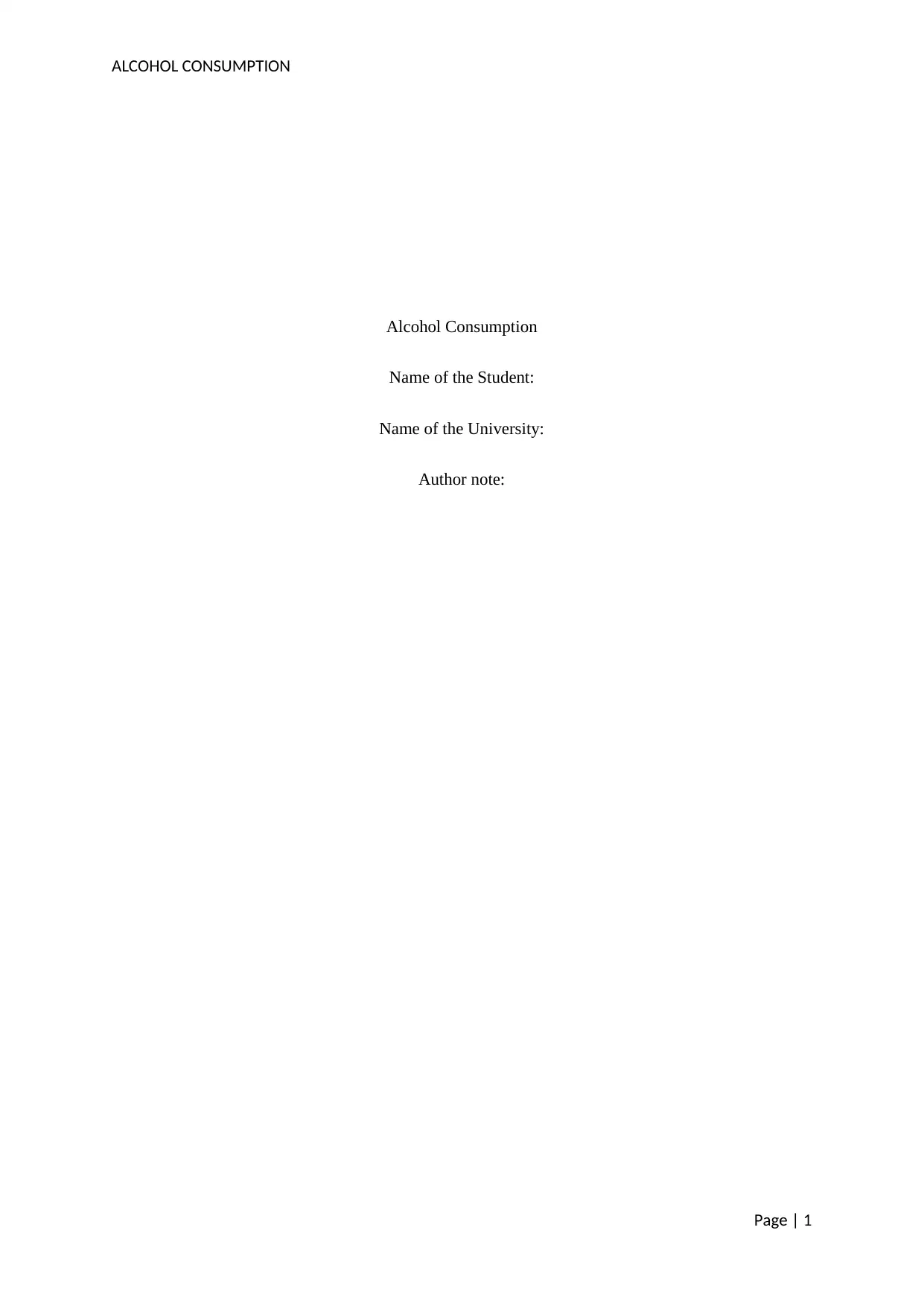
ALCOHOL CONSUMPTION
Alcohol Consumption
Name of the Student:
Name of the University:
Author note:
Page | 1
Alcohol Consumption
Name of the Student:
Name of the University:
Author note:
Page | 1
Paraphrase This Document
Need a fresh take? Get an instant paraphrase of this document with our AI Paraphraser
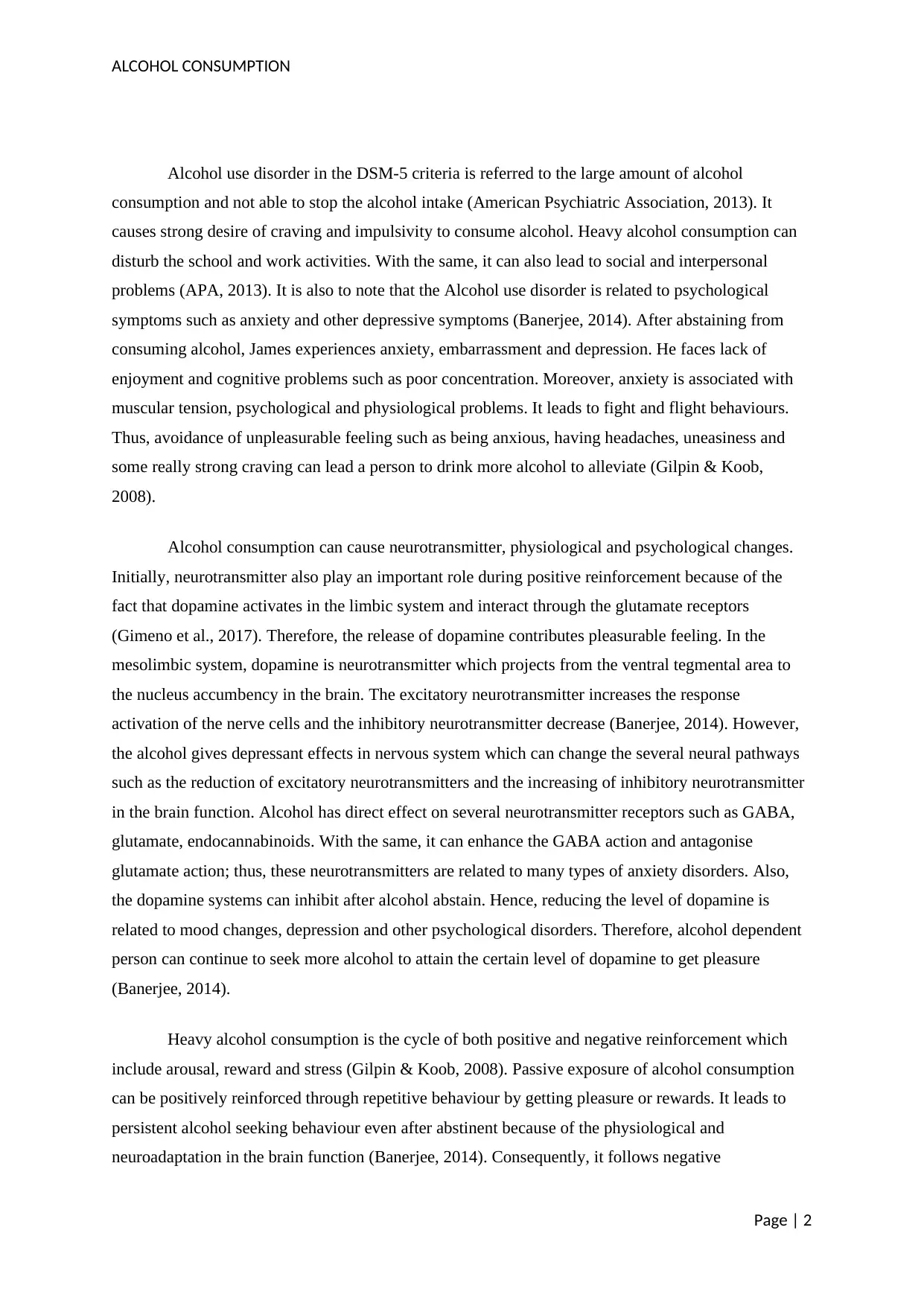
ALCOHOL CONSUMPTION
Alcohol use disorder in the DSM-5 criteria is referred to the large amount of alcohol
consumption and not able to stop the alcohol intake (American Psychiatric Association, 2013). It
causes strong desire of craving and impulsivity to consume alcohol. Heavy alcohol consumption can
disturb the school and work activities. With the same, it can also lead to social and interpersonal
problems (APA, 2013). It is also to note that the Alcohol use disorder is related to psychological
symptoms such as anxiety and other depressive symptoms (Banerjee, 2014). After abstaining from
consuming alcohol, James experiences anxiety, embarrassment and depression. He faces lack of
enjoyment and cognitive problems such as poor concentration. Moreover, anxiety is associated with
muscular tension, psychological and physiological problems. It leads to fight and flight behaviours.
Thus, avoidance of unpleasurable feeling such as being anxious, having headaches, uneasiness and
some really strong craving can lead a person to drink more alcohol to alleviate (Gilpin & Koob,
2008).
Alcohol consumption can cause neurotransmitter, physiological and psychological changes.
Initially, neurotransmitter also play an important role during positive reinforcement because of the
fact that dopamine activates in the limbic system and interact through the glutamate receptors
(Gimeno et al., 2017). Therefore, the release of dopamine contributes pleasurable feeling. In the
mesolimbic system, dopamine is neurotransmitter which projects from the ventral tegmental area to
the nucleus accumbency in the brain. The excitatory neurotransmitter increases the response
activation of the nerve cells and the inhibitory neurotransmitter decrease (Banerjee, 2014). However,
the alcohol gives depressant effects in nervous system which can change the several neural pathways
such as the reduction of excitatory neurotransmitters and the increasing of inhibitory neurotransmitter
in the brain function. Alcohol has direct effect on several neurotransmitter receptors such as GABA,
glutamate, endocannabinoids. With the same, it can enhance the GABA action and antagonise
glutamate action; thus, these neurotransmitters are related to many types of anxiety disorders. Also,
the dopamine systems can inhibit after alcohol abstain. Hence, reducing the level of dopamine is
related to mood changes, depression and other psychological disorders. Therefore, alcohol dependent
person can continue to seek more alcohol to attain the certain level of dopamine to get pleasure
(Banerjee, 2014).
Heavy alcohol consumption is the cycle of both positive and negative reinforcement which
include arousal, reward and stress (Gilpin & Koob, 2008). Passive exposure of alcohol consumption
can be positively reinforced through repetitive behaviour by getting pleasure or rewards. It leads to
persistent alcohol seeking behaviour even after abstinent because of the physiological and
neuroadaptation in the brain function (Banerjee, 2014). Consequently, it follows negative
Page | 2
Alcohol use disorder in the DSM-5 criteria is referred to the large amount of alcohol
consumption and not able to stop the alcohol intake (American Psychiatric Association, 2013). It
causes strong desire of craving and impulsivity to consume alcohol. Heavy alcohol consumption can
disturb the school and work activities. With the same, it can also lead to social and interpersonal
problems (APA, 2013). It is also to note that the Alcohol use disorder is related to psychological
symptoms such as anxiety and other depressive symptoms (Banerjee, 2014). After abstaining from
consuming alcohol, James experiences anxiety, embarrassment and depression. He faces lack of
enjoyment and cognitive problems such as poor concentration. Moreover, anxiety is associated with
muscular tension, psychological and physiological problems. It leads to fight and flight behaviours.
Thus, avoidance of unpleasurable feeling such as being anxious, having headaches, uneasiness and
some really strong craving can lead a person to drink more alcohol to alleviate (Gilpin & Koob,
2008).
Alcohol consumption can cause neurotransmitter, physiological and psychological changes.
Initially, neurotransmitter also play an important role during positive reinforcement because of the
fact that dopamine activates in the limbic system and interact through the glutamate receptors
(Gimeno et al., 2017). Therefore, the release of dopamine contributes pleasurable feeling. In the
mesolimbic system, dopamine is neurotransmitter which projects from the ventral tegmental area to
the nucleus accumbency in the brain. The excitatory neurotransmitter increases the response
activation of the nerve cells and the inhibitory neurotransmitter decrease (Banerjee, 2014). However,
the alcohol gives depressant effects in nervous system which can change the several neural pathways
such as the reduction of excitatory neurotransmitters and the increasing of inhibitory neurotransmitter
in the brain function. Alcohol has direct effect on several neurotransmitter receptors such as GABA,
glutamate, endocannabinoids. With the same, it can enhance the GABA action and antagonise
glutamate action; thus, these neurotransmitters are related to many types of anxiety disorders. Also,
the dopamine systems can inhibit after alcohol abstain. Hence, reducing the level of dopamine is
related to mood changes, depression and other psychological disorders. Therefore, alcohol dependent
person can continue to seek more alcohol to attain the certain level of dopamine to get pleasure
(Banerjee, 2014).
Heavy alcohol consumption is the cycle of both positive and negative reinforcement which
include arousal, reward and stress (Gilpin & Koob, 2008). Passive exposure of alcohol consumption
can be positively reinforced through repetitive behaviour by getting pleasure or rewards. It leads to
persistent alcohol seeking behaviour even after abstinent because of the physiological and
neuroadaptation in the brain function (Banerjee, 2014). Consequently, it follows negative
Page | 2
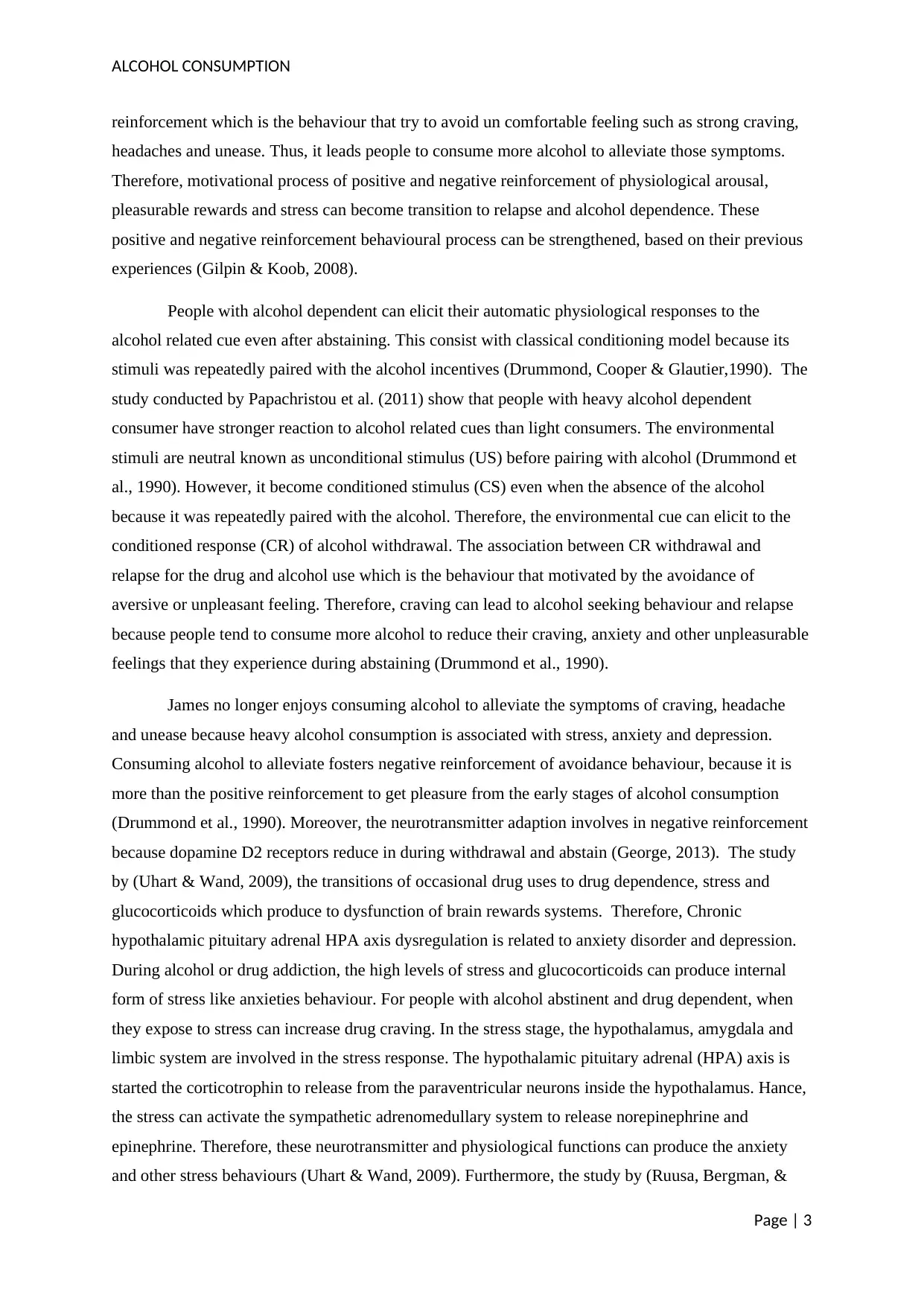
ALCOHOL CONSUMPTION
reinforcement which is the behaviour that try to avoid un comfortable feeling such as strong craving,
headaches and unease. Thus, it leads people to consume more alcohol to alleviate those symptoms.
Therefore, motivational process of positive and negative reinforcement of physiological arousal,
pleasurable rewards and stress can become transition to relapse and alcohol dependence. These
positive and negative reinforcement behavioural process can be strengthened, based on their previous
experiences (Gilpin & Koob, 2008).
People with alcohol dependent can elicit their automatic physiological responses to the
alcohol related cue even after abstaining. This consist with classical conditioning model because its
stimuli was repeatedly paired with the alcohol incentives (Drummond, Cooper & Glautier,1990). The
study conducted by Papachristou et al. (2011) show that people with heavy alcohol dependent
consumer have stronger reaction to alcohol related cues than light consumers. The environmental
stimuli are neutral known as unconditional stimulus (US) before pairing with alcohol (Drummond et
al., 1990). However, it become conditioned stimulus (CS) even when the absence of the alcohol
because it was repeatedly paired with the alcohol. Therefore, the environmental cue can elicit to the
conditioned response (CR) of alcohol withdrawal. The association between CR withdrawal and
relapse for the drug and alcohol use which is the behaviour that motivated by the avoidance of
aversive or unpleasant feeling. Therefore, craving can lead to alcohol seeking behaviour and relapse
because people tend to consume more alcohol to reduce their craving, anxiety and other unpleasurable
feelings that they experience during abstaining (Drummond et al., 1990).
James no longer enjoys consuming alcohol to alleviate the symptoms of craving, headache
and unease because heavy alcohol consumption is associated with stress, anxiety and depression.
Consuming alcohol to alleviate fosters negative reinforcement of avoidance behaviour, because it is
more than the positive reinforcement to get pleasure from the early stages of alcohol consumption
(Drummond et al., 1990). Moreover, the neurotransmitter adaption involves in negative reinforcement
because dopamine D2 receptors reduce in during withdrawal and abstain (George, 2013). The study
by (Uhart & Wand, 2009), the transitions of occasional drug uses to drug dependence, stress and
glucocorticoids which produce to dysfunction of brain rewards systems. Therefore, Chronic
hypothalamic pituitary adrenal HPA axis dysregulation is related to anxiety disorder and depression.
During alcohol or drug addiction, the high levels of stress and glucocorticoids can produce internal
form of stress like anxieties behaviour. For people with alcohol abstinent and drug dependent, when
they expose to stress can increase drug craving. In the stress stage, the hypothalamus, amygdala and
limbic system are involved in the stress response. The hypothalamic pituitary adrenal (HPA) axis is
started the corticotrophin to release from the paraventricular neurons inside the hypothalamus. Hance,
the stress can activate the sympathetic adrenomedullary system to release norepinephrine and
epinephrine. Therefore, these neurotransmitter and physiological functions can produce the anxiety
and other stress behaviours (Uhart & Wand, 2009). Furthermore, the study by (Ruusa, Bergman, &
Page | 3
reinforcement which is the behaviour that try to avoid un comfortable feeling such as strong craving,
headaches and unease. Thus, it leads people to consume more alcohol to alleviate those symptoms.
Therefore, motivational process of positive and negative reinforcement of physiological arousal,
pleasurable rewards and stress can become transition to relapse and alcohol dependence. These
positive and negative reinforcement behavioural process can be strengthened, based on their previous
experiences (Gilpin & Koob, 2008).
People with alcohol dependent can elicit their automatic physiological responses to the
alcohol related cue even after abstaining. This consist with classical conditioning model because its
stimuli was repeatedly paired with the alcohol incentives (Drummond, Cooper & Glautier,1990). The
study conducted by Papachristou et al. (2011) show that people with heavy alcohol dependent
consumer have stronger reaction to alcohol related cues than light consumers. The environmental
stimuli are neutral known as unconditional stimulus (US) before pairing with alcohol (Drummond et
al., 1990). However, it become conditioned stimulus (CS) even when the absence of the alcohol
because it was repeatedly paired with the alcohol. Therefore, the environmental cue can elicit to the
conditioned response (CR) of alcohol withdrawal. The association between CR withdrawal and
relapse for the drug and alcohol use which is the behaviour that motivated by the avoidance of
aversive or unpleasant feeling. Therefore, craving can lead to alcohol seeking behaviour and relapse
because people tend to consume more alcohol to reduce their craving, anxiety and other unpleasurable
feelings that they experience during abstaining (Drummond et al., 1990).
James no longer enjoys consuming alcohol to alleviate the symptoms of craving, headache
and unease because heavy alcohol consumption is associated with stress, anxiety and depression.
Consuming alcohol to alleviate fosters negative reinforcement of avoidance behaviour, because it is
more than the positive reinforcement to get pleasure from the early stages of alcohol consumption
(Drummond et al., 1990). Moreover, the neurotransmitter adaption involves in negative reinforcement
because dopamine D2 receptors reduce in during withdrawal and abstain (George, 2013). The study
by (Uhart & Wand, 2009), the transitions of occasional drug uses to drug dependence, stress and
glucocorticoids which produce to dysfunction of brain rewards systems. Therefore, Chronic
hypothalamic pituitary adrenal HPA axis dysregulation is related to anxiety disorder and depression.
During alcohol or drug addiction, the high levels of stress and glucocorticoids can produce internal
form of stress like anxieties behaviour. For people with alcohol abstinent and drug dependent, when
they expose to stress can increase drug craving. In the stress stage, the hypothalamus, amygdala and
limbic system are involved in the stress response. The hypothalamic pituitary adrenal (HPA) axis is
started the corticotrophin to release from the paraventricular neurons inside the hypothalamus. Hance,
the stress can activate the sympathetic adrenomedullary system to release norepinephrine and
epinephrine. Therefore, these neurotransmitter and physiological functions can produce the anxiety
and other stress behaviours (Uhart & Wand, 2009). Furthermore, the study by (Ruusa, Bergman, &
Page | 3
⊘ This is a preview!⊘
Do you want full access?
Subscribe today to unlock all pages.

Trusted by 1+ million students worldwide
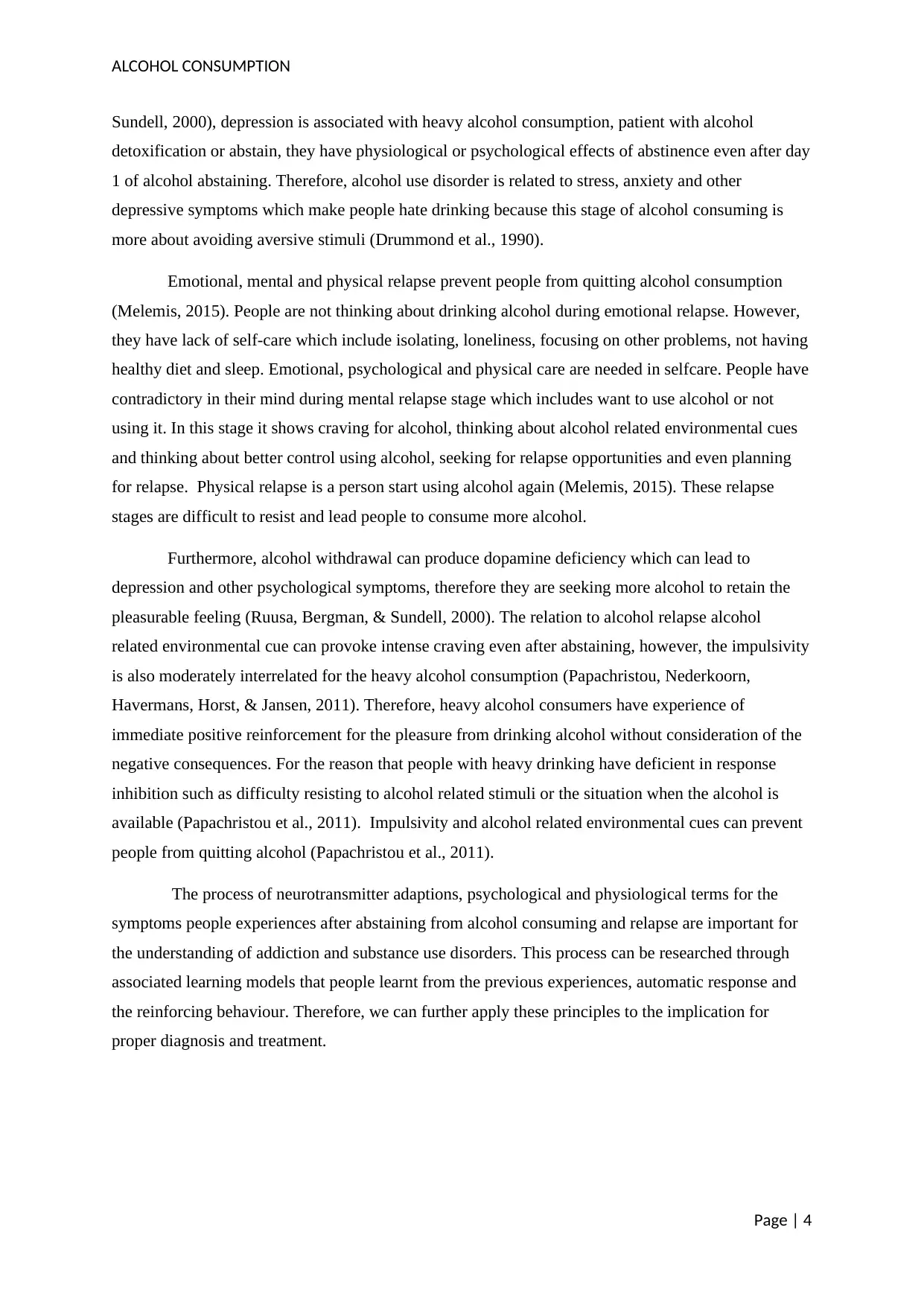
ALCOHOL CONSUMPTION
Sundell, 2000), depression is associated with heavy alcohol consumption, patient with alcohol
detoxification or abstain, they have physiological or psychological effects of abstinence even after day
1 of alcohol abstaining. Therefore, alcohol use disorder is related to stress, anxiety and other
depressive symptoms which make people hate drinking because this stage of alcohol consuming is
more about avoiding aversive stimuli (Drummond et al., 1990).
Emotional, mental and physical relapse prevent people from quitting alcohol consumption
(Melemis, 2015). People are not thinking about drinking alcohol during emotional relapse. However,
they have lack of self-care which include isolating, loneliness, focusing on other problems, not having
healthy diet and sleep. Emotional, psychological and physical care are needed in selfcare. People have
contradictory in their mind during mental relapse stage which includes want to use alcohol or not
using it. In this stage it shows craving for alcohol, thinking about alcohol related environmental cues
and thinking about better control using alcohol, seeking for relapse opportunities and even planning
for relapse. Physical relapse is a person start using alcohol again (Melemis, 2015). These relapse
stages are difficult to resist and lead people to consume more alcohol.
Furthermore, alcohol withdrawal can produce dopamine deficiency which can lead to
depression and other psychological symptoms, therefore they are seeking more alcohol to retain the
pleasurable feeling (Ruusa, Bergman, & Sundell, 2000). The relation to alcohol relapse alcohol
related environmental cue can provoke intense craving even after abstaining, however, the impulsivity
is also moderately interrelated for the heavy alcohol consumption (Papachristou, Nederkoorn,
Havermans, Horst, & Jansen, 2011). Therefore, heavy alcohol consumers have experience of
immediate positive reinforcement for the pleasure from drinking alcohol without consideration of the
negative consequences. For the reason that people with heavy drinking have deficient in response
inhibition such as difficulty resisting to alcohol related stimuli or the situation when the alcohol is
available (Papachristou et al., 2011). Impulsivity and alcohol related environmental cues can prevent
people from quitting alcohol (Papachristou et al., 2011).
The process of neurotransmitter adaptions, psychological and physiological terms for the
symptoms people experiences after abstaining from alcohol consuming and relapse are important for
the understanding of addiction and substance use disorders. This process can be researched through
associated learning models that people learnt from the previous experiences, automatic response and
the reinforcing behaviour. Therefore, we can further apply these principles to the implication for
proper diagnosis and treatment.
Page | 4
Sundell, 2000), depression is associated with heavy alcohol consumption, patient with alcohol
detoxification or abstain, they have physiological or psychological effects of abstinence even after day
1 of alcohol abstaining. Therefore, alcohol use disorder is related to stress, anxiety and other
depressive symptoms which make people hate drinking because this stage of alcohol consuming is
more about avoiding aversive stimuli (Drummond et al., 1990).
Emotional, mental and physical relapse prevent people from quitting alcohol consumption
(Melemis, 2015). People are not thinking about drinking alcohol during emotional relapse. However,
they have lack of self-care which include isolating, loneliness, focusing on other problems, not having
healthy diet and sleep. Emotional, psychological and physical care are needed in selfcare. People have
contradictory in their mind during mental relapse stage which includes want to use alcohol or not
using it. In this stage it shows craving for alcohol, thinking about alcohol related environmental cues
and thinking about better control using alcohol, seeking for relapse opportunities and even planning
for relapse. Physical relapse is a person start using alcohol again (Melemis, 2015). These relapse
stages are difficult to resist and lead people to consume more alcohol.
Furthermore, alcohol withdrawal can produce dopamine deficiency which can lead to
depression and other psychological symptoms, therefore they are seeking more alcohol to retain the
pleasurable feeling (Ruusa, Bergman, & Sundell, 2000). The relation to alcohol relapse alcohol
related environmental cue can provoke intense craving even after abstaining, however, the impulsivity
is also moderately interrelated for the heavy alcohol consumption (Papachristou, Nederkoorn,
Havermans, Horst, & Jansen, 2011). Therefore, heavy alcohol consumers have experience of
immediate positive reinforcement for the pleasure from drinking alcohol without consideration of the
negative consequences. For the reason that people with heavy drinking have deficient in response
inhibition such as difficulty resisting to alcohol related stimuli or the situation when the alcohol is
available (Papachristou et al., 2011). Impulsivity and alcohol related environmental cues can prevent
people from quitting alcohol (Papachristou et al., 2011).
The process of neurotransmitter adaptions, psychological and physiological terms for the
symptoms people experiences after abstaining from alcohol consuming and relapse are important for
the understanding of addiction and substance use disorders. This process can be researched through
associated learning models that people learnt from the previous experiences, automatic response and
the reinforcing behaviour. Therefore, we can further apply these principles to the implication for
proper diagnosis and treatment.
Page | 4
Paraphrase This Document
Need a fresh take? Get an instant paraphrase of this document with our AI Paraphraser
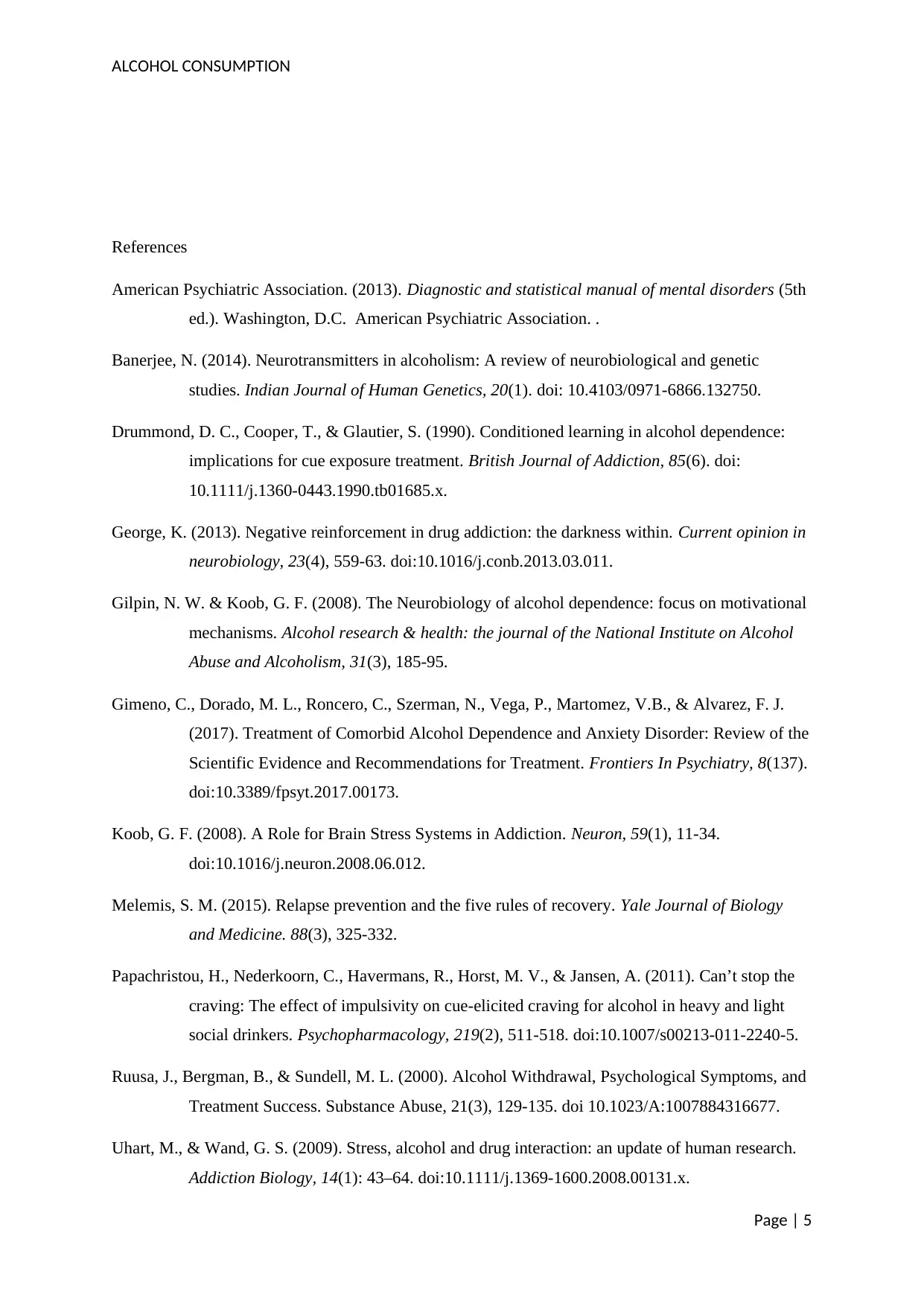
ALCOHOL CONSUMPTION
References
American Psychiatric Association. (2013). Diagnostic and statistical manual of mental disorders (5th
ed.). Washington, D.C. American Psychiatric Association. .
Banerjee, N. (2014). Neurotransmitters in alcoholism: A review of neurobiological and genetic
studies. Indian Journal of Human Genetics, 20(1). doi: 10.4103/0971-6866.132750.
Drummond, D. C., Cooper, T., & Glautier, S. (1990). Conditioned learning in alcohol dependence:
implications for cue exposure treatment. British Journal of Addiction, 85(6). doi:
10.1111/j.1360-0443.1990.tb01685.x.
George, K. (2013). Negative reinforcement in drug addiction: the darkness within. Current opinion in
neurobiology, 23(4), 559-63. doi:10.1016/j.conb.2013.03.011.
Gilpin, N. W. & Koob, G. F. (2008). The Neurobiology of alcohol dependence: focus on motivational
mechanisms. Alcohol research & health: the journal of the National Institute on Alcohol
Abuse and Alcoholism, 31(3), 185-95.
Gimeno, C., Dorado, M. L., Roncero, C., Szerman, N., Vega, P., Martomez, V.B., & Alvarez, F. J.
(2017). Treatment of Comorbid Alcohol Dependence and Anxiety Disorder: Review of the
Scientific Evidence and Recommendations for Treatment. Frontiers In Psychiatry, 8(137).
doi:10.3389/fpsyt.2017.00173.
Koob, G. F. (2008). A Role for Brain Stress Systems in Addiction. Neuron, 59(1), 11-34.
doi:10.1016/j.neuron.2008.06.012.
Melemis, S. M. (2015). Relapse prevention and the five rules of recovery. Yale Journal of Biology
and Medicine. 88(3), 325-332.
Papachristou, H., Nederkoorn, C., Havermans, R., Horst, M. V., & Jansen, A. (2011). Can’t stop the
craving: The effect of impulsivity on cue-elicited craving for alcohol in heavy and light
social drinkers. Psychopharmacology, 219(2), 511-518. doi:10.1007/s00213-011-2240-5.
Ruusa, J., Bergman, B., & Sundell, M. L. (2000). Alcohol Withdrawal, Psychological Symptoms, and
Treatment Success. Substance Abuse, 21(3), 129-135. doi 10.1023/A:1007884316677.
Uhart, M., & Wand, G. S. (2009). Stress, alcohol and drug interaction: an update of human research.
Addiction Biology, 14(1): 43–64. doi:10.1111/j.1369-1600.2008.00131.x.
Page | 5
References
American Psychiatric Association. (2013). Diagnostic and statistical manual of mental disorders (5th
ed.). Washington, D.C. American Psychiatric Association. .
Banerjee, N. (2014). Neurotransmitters in alcoholism: A review of neurobiological and genetic
studies. Indian Journal of Human Genetics, 20(1). doi: 10.4103/0971-6866.132750.
Drummond, D. C., Cooper, T., & Glautier, S. (1990). Conditioned learning in alcohol dependence:
implications for cue exposure treatment. British Journal of Addiction, 85(6). doi:
10.1111/j.1360-0443.1990.tb01685.x.
George, K. (2013). Negative reinforcement in drug addiction: the darkness within. Current opinion in
neurobiology, 23(4), 559-63. doi:10.1016/j.conb.2013.03.011.
Gilpin, N. W. & Koob, G. F. (2008). The Neurobiology of alcohol dependence: focus on motivational
mechanisms. Alcohol research & health: the journal of the National Institute on Alcohol
Abuse and Alcoholism, 31(3), 185-95.
Gimeno, C., Dorado, M. L., Roncero, C., Szerman, N., Vega, P., Martomez, V.B., & Alvarez, F. J.
(2017). Treatment of Comorbid Alcohol Dependence and Anxiety Disorder: Review of the
Scientific Evidence and Recommendations for Treatment. Frontiers In Psychiatry, 8(137).
doi:10.3389/fpsyt.2017.00173.
Koob, G. F. (2008). A Role for Brain Stress Systems in Addiction. Neuron, 59(1), 11-34.
doi:10.1016/j.neuron.2008.06.012.
Melemis, S. M. (2015). Relapse prevention and the five rules of recovery. Yale Journal of Biology
and Medicine. 88(3), 325-332.
Papachristou, H., Nederkoorn, C., Havermans, R., Horst, M. V., & Jansen, A. (2011). Can’t stop the
craving: The effect of impulsivity on cue-elicited craving for alcohol in heavy and light
social drinkers. Psychopharmacology, 219(2), 511-518. doi:10.1007/s00213-011-2240-5.
Ruusa, J., Bergman, B., & Sundell, M. L. (2000). Alcohol Withdrawal, Psychological Symptoms, and
Treatment Success. Substance Abuse, 21(3), 129-135. doi 10.1023/A:1007884316677.
Uhart, M., & Wand, G. S. (2009). Stress, alcohol and drug interaction: an update of human research.
Addiction Biology, 14(1): 43–64. doi:10.1111/j.1369-1600.2008.00131.x.
Page | 5
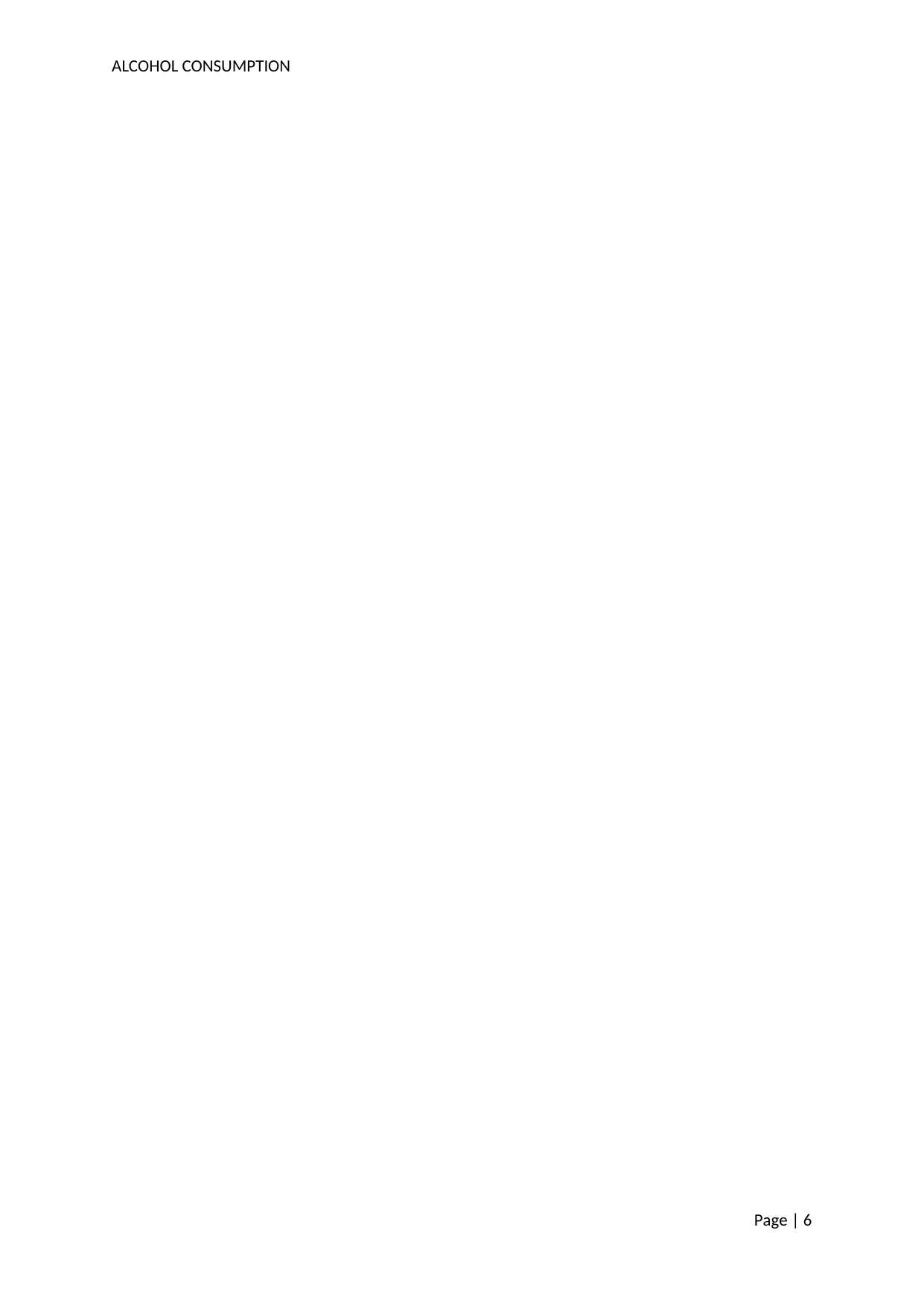
ALCOHOL CONSUMPTION
Page | 6
Page | 6
⊘ This is a preview!⊘
Do you want full access?
Subscribe today to unlock all pages.

Trusted by 1+ million students worldwide
1 out of 6
Your All-in-One AI-Powered Toolkit for Academic Success.
+13062052269
info@desklib.com
Available 24*7 on WhatsApp / Email
![[object Object]](/_next/static/media/star-bottom.7253800d.svg)
Unlock your academic potential
Copyright © 2020–2025 A2Z Services. All Rights Reserved. Developed and managed by ZUCOL.


